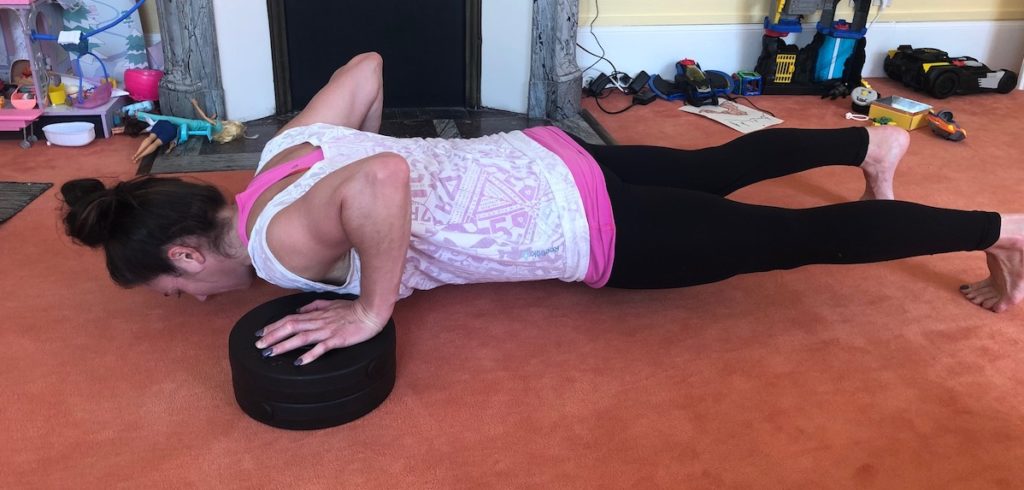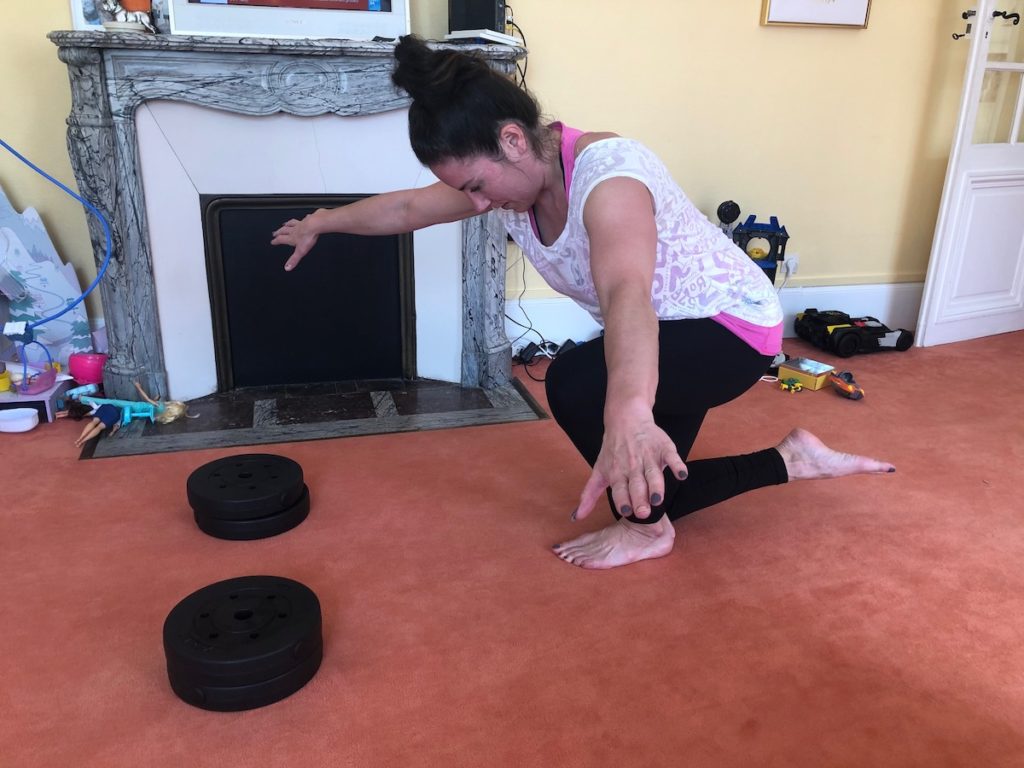Tired of Air Squats, Burpees, and Lunges on Repeat? | BarBend (original) (raw)
In the post-barbell world of home workouts, clients, friends and family members keep coming to me with the same concerns.
“I’m getting bored of air squats and lunges. My hips are sore from doing 100 squats and 100 lunges everyday. How can I make my workouts harder without doing so many reps?”
Here are five ideas to ease the boredom, increase the difficulty, and reduce the volume so you don’t have to do hundreds of reps to feel like you “had a good workout.”
1. Tempo Times
Slow down your movements through tempo training.
For example, take your five sets of 10 push-ups, and turn it into this:
5 x 6-10 push-ups @2222.
This means, lower for two seconds, hover with you chest just above the floor while maintaining tension in your body for two seconds, drive up for two seconds and hold for two seconds at the top.
Do the same with split squats: Try 5 x 10 split squats per leg @3311.
This means lower for three second, hold with your hip crease below your knee for three seconds, stand up for one second and pause for one second at the top. This allows your body to reap the benefits from spending a lot of time under tension without having to log 100 reps in the process. One set @3311 will take 80 seconds for just 10 reps, and you will feel the burn.
The tempo principle can be applied to pretty much any squat, hinge, pull or pushing movement you’re currently doing at home, such as:
- Air squats
- Lunges
- Inverted table rows
- Chair dips
Finally, try this for a challenge: V-sits @2222. Even the fittest of the fit find this difficult. (If that’s too hard, add a tempo to your sit-ups instead of V-sits).
[Read More: Train to Do 100 Push-Ups a Day]
2. Deficit Days

Finding ways to increase your range of motion is another simple way to make your body work a little harder on bodyweight movements without logging so much volume.
For push-ups—or handstand push-ups for the more advanced—grab a book or two. Place your hands on the books, so that when you descend, your body (or head in the case of a handstand push-up) ends up in a deficit. Just make sure the books are the same height, so you’re not pushing unevenly.
For split squats, turn them into Bulgarian split squats with a tempo.
I did five sets of 8 Bulgarian split squat @3311 supersetted with five sets of 6 deficit book push-ups @2222 yesterday morning and felt my body nearly shaking (in a good way) by the end of my workout. Less volume, more gains.
3. Isometric Intervals
Isometrics are movements involving a static contraction of the muscle, where you aren’t changing the angle of the joint. In other words, movements where you’re holding in a consistent position, such as a plank hold.
Three ways I have taken advantage of isometrics at home in recent days include:
Wall sits: With you back against the wall, sit and hold in an active position with your hip crease parallel to your knee. Hold for 60 seconds. If that isn’t challenging for you, then try the same thing on a single leg. Rest 30 seconds and repeat three to five times.
Tabata Hollow holds: 20 seconds on, 20 seconds x 8 intervals. If you feel your lower back peeling off the ground, or you’re unable to hold your hands over your head or keep your shoulder blades off the ground, then move to a bent hollow hold as you fatigue.
Chest to table hold: Pull yourself to the top of an inverted table row and hold. This essentially mimics holding the top of a ring row or bar row. Hold for 10-30 seconds (depending on your abilities) with your chest touching the table. Rest for 30 seconds and repeat five times.
Lunge hold: Get into a lunge position with your back knee touching the ground. Then lift the back knee two inches off the ground, all the while keeping your bum tucked under so you don’t end up in spinal extension. Hold for 30 seconds. Rest 30 seconds and repeat three times per leg.
4. Single-leg Sundays
Moving to single-leg work is always a great way to mix things up and increase the difficulty of a movement.
Here are three ideas:
Replace air squats with single-leg pistol squats: If those are too difficult, then try a single-leg pistol squat to a chair. Make sure the chair is at a height where you’re able to stand back up unassisted.
Add some single-leg (bodyweight) RDLs to your warm-up: They’re a great way to improve balance and build some single-leg strength. Make sure your spine stays neutral the whole time. If you’re not sure whether or not it is, place a broomstick on your back and ensure your head, back and bum remain in contact with the broomstick throughout the movement.

Try skater squats: Stand on your left leg and slowly lower your right knee to the ground, touching it to the floor right next to your left ankle. Then stand back up again without touching your right shin or right foot on the ground. I find these as hard as pistol squats from a strength standpoint, but they don’t require as much balance or flexibility.

5. Resistance Rush
Adding some resistance is another way of increasing the difficulty and allowing you to reduce the number of reps you need to reap the benefits. If you have resistance bands, they’re the easiest way to add resistance to your training, but a partner also works.
Here are three ideas:
Bully deadbugs or planks: Assume a deadbug or plank position and ask your partner to tap you and try to move you out of position. On your end, build as much tension in your body to resist the bullying. Go for 30 seconds, and have your partner push you in various directions, on various places of your body, every three or four seconds. Each time you’re moved out of place, stabilize hard through your core and return to a perfect plank or deadbug position.
Resistance push-ups or chair dips: As you’re doing push-ups or chair dips, have your partner place their hands on your back if you’re doing a push-up—or their hands on your shoulders if you’re doing a dip—and then apply pressure downwards as you’re pushing out of your push-up or dip. The stronger you are, the more pressure they can apply.